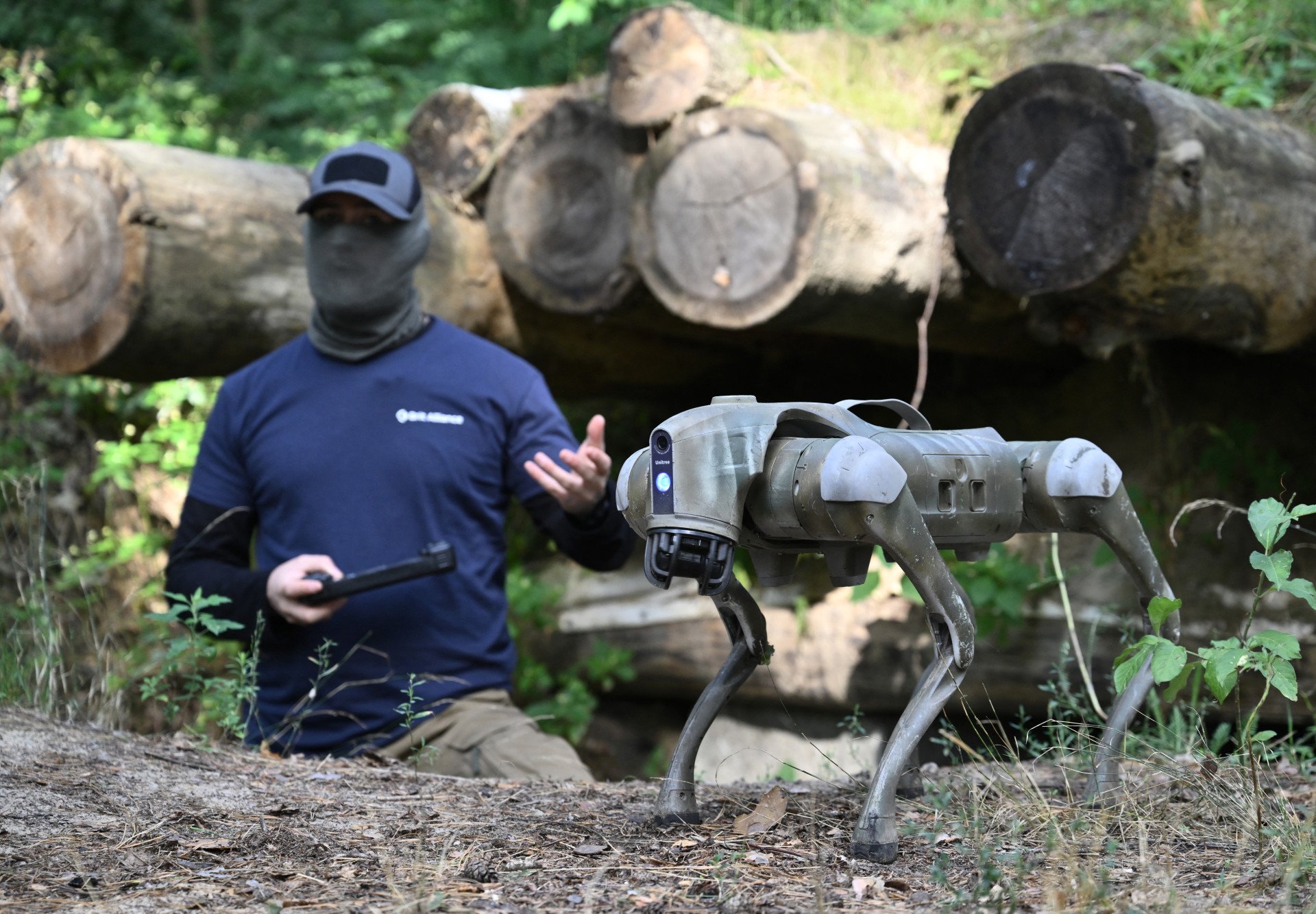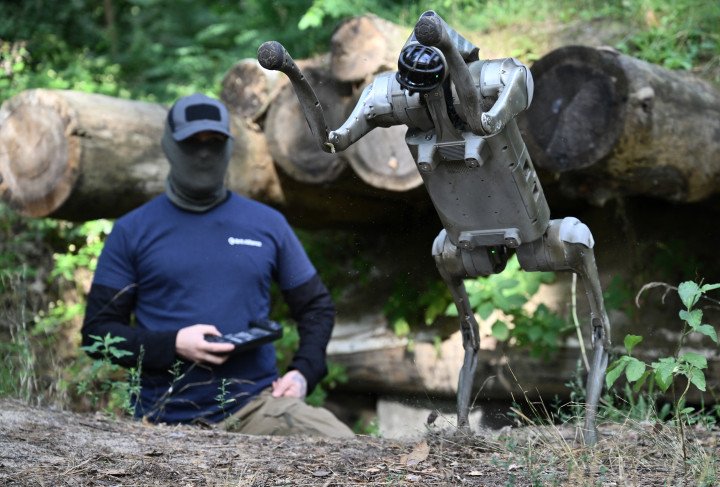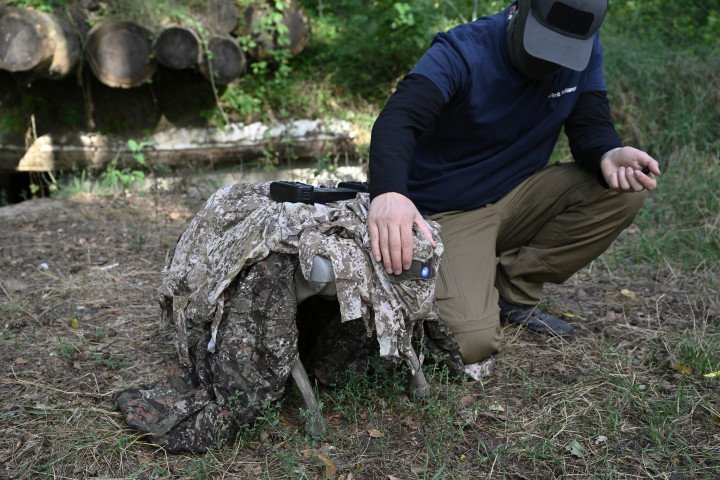- Category
- War in Ukraine
Robot Dogs, Ukraine’s Latest Frontline Companions

Robot dogs are now being used on the frontlines in Ukraine. What are these four legged machines? What can they do? And will we see weapon mounted robot dogs on Ukraine’s frontlines?
The British robotic dog, specifically the BAD2 model, is now working the frontlines in Ukraine and currently being used by the Kurt & Company unit of the 28th Mechanised Brigade. Technology is the bedrock of modern warfare and Ukrainians are the pioneers of showcasing an array of advanced tech on the battlefield.
Since the full-scale invasion in February 2022, we’ve seen huge advancements in Unmanned Aerial Vehicles (UAVs), with drone usage becoming fully integrated into the Ukrainian Armed Forces. Eyes in the sky have become key to both offensive and defensive operations. Still, the giant fleet of UAVs have their own vulnerabilities.
With fighting still fierce on the frontline, Ukraine seeks to minimize human loss and enhance the army’s effectiveness by further evolving its armament with Unmanned Ground Vehicles (UGVs). We’ve been an increase in use of ‘killer robots’ used for reconnaissance missions, evacuations and replenishing frontline supplies.
Now, the robot dog is supporting Ukrainian personnel in their fight against Russian invasion and Ukrainians are the first to use them directly in combat missions.

The BAD2 is an Unmanned Ground Vehicle (UGV), which means that it can be operated by the military with a remote control from a safe distance. Previously robotic dogs were used by Western armies for guarding military bases and airfields.
The BAD2 has an FPV camera (first person view) and can stealthily move from positions allowing it to perform surveillance and reconnaissance, feeding video information back to personnel operating the dog.
🤖 A video surfaced online showing the robodog now used by Ukrainian forces on the frontlines. These robotic dogs move low to the ground, making them hard to detect, with a battery life of up to 2 hours. #UkraineWar #MilitaryTech pic.twitter.com/Zq64k06yvx
— Ukraine Lives Matter (@ULM_Info) August 12, 2024
Its four legs and its balance system gives the robo-dog more stability and mobility, allowing it to overcome obstacles and uneven surfaces. With its advanced sensors and cameras it’s able to accurately avoid obstacles and perceive its surroundings. Any data recorded by the dog can be instantly erased if captured by Russian forces, removing their chances of gaining any valuable information from it.
Ukraine is continuously finding ways to remove the human aspect from dangerous missions and preserve life through technology. It can explore indoor environments, buildings being occupied by Russian forces, bunkers and trench systems which are difficult to reach for military men, without facing severe risk.
Some drones have shrouded rotors which are able to operate inside buildings, but they are rare and flying them is extremely difficult. Drones will also fly over trip wires, mines and other explosives placed on the ground whereas the BAD2 can trigger these, therefore foot soldiers can walk more safely in the dogs path. Robots can be replaced, but a human life can not.

⚡️🇬🇧British robot dogs used by the 🇺🇦Ukrainian military pic.twitter.com/Pqc2oY7qks
— 🪖MilitaryNewsUA🇺🇦 (@front_ukrainian) August 19, 2024
Where have robotic dogs been used already?
The BigDog—one of the first—it was made in 2005 intended to transport weapons and supplies for US troops. It was discontinued after a decade due to noise concerns and was deemed too loud for practical use. Spot, an American made smaller and quieter model was first seen in 2015. Too small to transport weapons and supplies, it was used for reconnaissance, security and remote site inspection. Spot inspired other manufacturers to produce more robotic dogs and likely influenced the technology seen today.
According to Defense Visual Information Distribution Service (DVIDS), the Pentagon’s media distribution hub, robotic dogs were not actually used to a great extent until 2020. Since then they have become an increasingly common asset of the US Military.
For example; the Minot Air Force Base in North Dakota used them to support the base against chemical, biological, radiological and nuclear threats. The Patrick Space Force Base in Florida began using them to identify dangerous and hazardous situations. “While also speeding up accurate reaction times to incidents and aiding in the recovery of survivors from natural catastrophes like hurricanes.”
Though in these examples robotic dogs were not used for combat missions, like in Ukraine. It’s reported that China is already mass producing robot dogs armed with machine guns, rocket launchers, and flamethrowers.
#China's #PLA is mass producing combat “dog drones"
— Indo-Pacific News - Geo-Politics & Defense (@IndoPac_Info) June 2, 2024
They can carry machine guns, rocket launchers and flamethrowers.
The flamethrower dog is particularly lethal. pic.twitter.com/jxUypNZwvJ
China’s state owned news agency CCTV released footage of China’s People's Liberation Army personnel training with a robot dog with an assault rifle mounted to it. In 2022, the Chinese defense contractor Kestrel Defense released a video of a ‘quadcopter’ drone air-dropping a robot dog with a light machine gun mounted to it on a roof.
Blood-Wing, a Chinese defense contractor, demonstrates drone-deploying an armed robodog.
— Lia Wong (@LiaWong__) October 4, 2022
The Future is Now. pic.twitter.com/tRKnKa8xvp
In March of this year, 2024, Chinese researchers according to South China Morning Post, claimed that these dogs were able to fire their weapons with the skills of a trained marksman. Claiming that the “the findings could revolutionize the future of warfare, particularly when fighting battles in an urban landscape.”
At Russia’s “Army 2022” arms expo, Russia showcased a robot dog armed with a grenade launcher. Though it is yet to be reported to have been seen working on the frontlines in Ukraine.
Video of the M-81 robot-dog armed with an RPG-26 at the Army 2022 defense expo. https://t.co/rUnwoCMoyS pic.twitter.com/BEDjnwstN0
— Rob Lee (@RALee85) August 15, 2022
In May 2024, U.S Marine Special Operators were reported to also showcase their robotic dogs with mounted weapons.
The BAD2 being used in Ukraine are not yet armed, but armed robotics have been an ongoing trend, some of which are already being used by Ukrainian forces, entering a new age of ‘killer robots’.
Ukraines killer robots:
The D-21-11 is a versatile machine that can be reworked from a transport system to a weapon system in just a few minutes while directly on the frontline. A machine gun can be loaded onto the system within minutes. It has an automatic turret and can be operated remotely by the machine gunner. It's used for reconnaissance, evacuations and offensive operations.
The Ukrainian produced Ratel-S UGV was used to blow up a bridge, preventing advancement from the enemy. Another video shows a Ukrainian UGV loaded with explosives detonating under a road overpass, reportedly in Russian-occupied territory.
In April 2024 a video circulated from the 23rd Separate Rifle Battalion of the 63rd Brigade approaching Russian trenches with a kamikaze ground drone charge blasting their positions.
"Lyut 2.0" is mounted with a machine and can operate autonomously for up to three days.
Russia is also beginning to roll out UGVs on the frontlines and has claimed to have produced the “first strike FPV (first-person view) ground drone.” Depesha and Buggy are two robotic systems designed to hit targets by charge blasting.
Brave1 – created by Ukraine’s Government – is a united coordinational platform for Defence Tech to facilitate collaboration projects which have recently focused on advancing UGV capabilities.
They claim that their UGV systems already surpass Russia’s arsenal in quantity and quality, equipping the Ukrainian army with the tools to defend effectively while minimizing human loss. They said “By the end of 2024, the use of UGVs will become a systematic part of our military actions to repel Russian aggression.”
“Uncanny Valley” a psychological fear of robots:
The ‘uncanny valley’ is a concept first introduced in the 1970s by Masahiro Mori, then a professor at the Tokyo Institute of Technology. The ‘uncanny valley’ is a common unsettling feeling people experience when androids or humanoid robots and audio/visual simulations closely resemble humans, this case, dogs, in many respects but aren't quite convincingly realistic.
The idea of armed dystopian robotic dogs causing worldwide destruction was seen in the Black mirror tv series, in the episode named “Metalhead”. Black Mirror is produced to create an unsettling feeling of the modern tech world and how in very extreme cases, it could go wrong.
Since “Metalhead” was aired, the public became nervous about the use of robot dogs.The New York Police Department stopped using their robot dogs for two years after receiving backlash from residents who felt unsettled, and felt that it was aggressive policing.
Spot pioneer Boston Dynamics in 2022, released a letter pledging not to weaponize their robots for combat purposes. “Weaponized applications of these newly-capable robots will also harm public trust in the technology in ways that damage the tremendous benefits they will bring to society.”
However, China is increasingly mass producing weapon mounted robot dogs. China is seen as a threat to US relations, especially as China is increasing cooperation with states such as Russia and Iran, though currently in a more economical scope rather than military exchanges.
The grenade launcher mounted robot dog seen in Russia’s “Army 2022” arms expo was found to be a Chinese made robot. Its shape and optical sensors, as well as the robot’s overall frame, visually matches that of Go1, created by the Chinese startup Unitree Robotics.
It is not known whether it was a copy, or whether they worked in direct participation with one another. However, the striking resemblance between the two leads to the conclusion that Russia could further produce similar robo-dogs to current Chinese bots on the market.
Russia’s aggression in Ukraine has far from halted and should Russia develop and deploy weapon mounted robo-dogs seen in their “Army 2022” arms expo, Ukrainian forces would also need to start deploying weaponed mounted variants to counterbalance their force.
The commander of the Ukrainian unit Kurt & Company, whose call sign is “Kurt”, told The Telegraph that his unit is altering their dogs “to act as a kamikaze (strike) drone against vehicles or enemy soldiers”.
“We will start using them en masse after the complete modernisation of the robo-dogs to our needs,” he added. “The process is already underway.”
It's vital to note that the BAD2 robotic dogs used by Ukrainian forces are fully human operated with no autonomy-related systems that could go wrong in extreme circumstances. Scenes from the Black Mirror episode are far from materializing within civilian life in Ukraine.
Ukraine is vastly developing UGVs and are increasingly using tracked and wheeled UGVs with mounted weapons systems.Therefore it is possible that armed robot dogs could be deployed to Ukraine’s frontlines in the future.
-46f6afa2f66d31ff3df8ea1a8f5524ec.jpg)
-c42261175cd1ec4a358bec039722d44f.jpg)
-6359eca46c72bde40a90abaaadd6eaa8.png)
-29a1a43aba23f9bb779a1ac8b98d2121.jpeg)


-206008aed5f329e86c52788e3e423f23.jpg)